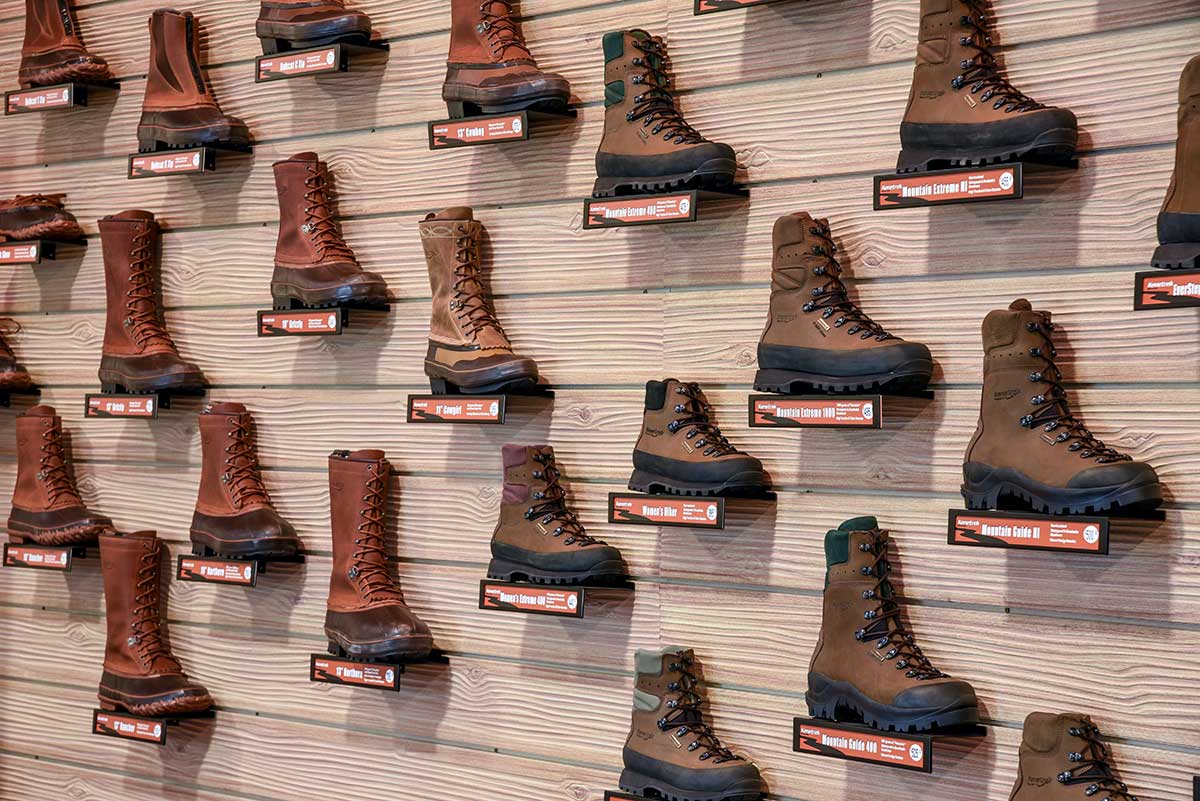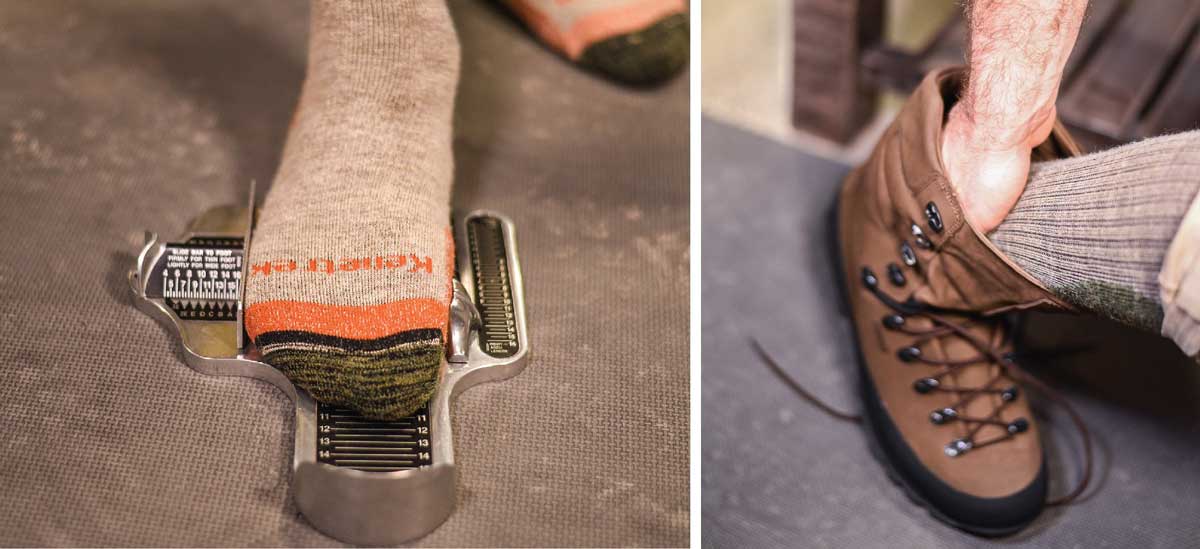Anyone who has hunted in the mountains recognizes how important supportive and proper fitting boots can be. Most mountain hunting guides can tell you horror stories of their hunter’s badly damaged feet ending or severely impairing their “once in a lifetime hunt.” Until you have suffered this pain and agony personally, it is hard to completely understand how important your feet are to a mountain hunt. If your feet fail you, all of the expensive hunting gear you own will be worthless, as successful hunting is impossible when you are laid up in camp nursing your feet.
We have assisted many thousands of hunters with their footwear needs over the last 20 years and have learned several selection and fitting “tips” that can assist you in finding the perfect (or as close to possible) boot for your next hunt. The reason that I say “assist” is because personal responsibility with the fit of your boots is essential. Everyone’s feet are different and no one brand or style of boot works for all.
1. STARTING THE BOOT SELECTION PROCESS
The first step in the process is to select the proper style of boot for your hunting needs. Several factors need to be considered:
- The type of terrain you will be hunting in. Sheep hunting in the Chugach Mountains of Alaska may require a different type of boot than a Wyoming elk hunt.
- The expected temperature range on your hunt. A rut hunt for Alberta Bighorn in November has far different insulation needs than a desert sheep hunt in Baja Mexico.
- Required durability for your hunts. The perfect boot for a sheep guide who is guiding 6 consecutive hunts after a month of scouting is not necessarily the best choice for the hunter going on one hunt. That extra durability that the guide needs often requires a very stiff and more durable boot.
- Your own personal toughness. Similar to the previous factor, you need to honestly evaluate your physical stamina and how hard you hunt. I know that most of us tend to think we are pretty tough hunters, but most guides I know say the average sheep hunter has only 4 days in them before they are done. Again, the point here is that you need to select a boot that works for you, which may not be the same as the best boot for your guide. Trust me on this one, everyone usually knows who is the hunter and who is the guide after the first day. Other factors like boot height, boot weight, waterproofness, and breathability may also come into play, but these main factors should help to start your selection process. At Kenetrek Boots, we strive to design and build boots that will fit any and all combinations of the above factors.

2. FINDING YOUR PROPER SIZE
When you have determined what style of boot you need, finding the best fitting boot is the next step. There are many excellent mountain boots on the market today. They all are constructed differently and are built on different lasts, therefore each style of boot will tend to fit differently as well. It is important to try the boots on first. I recommend trying on several styles from different manufacturers to find the best fit for your feet.
You should try to have your feet measured using a brannock measuring device. The brannock can measure your overall foot length, length of your arch, and foot width.
With your size measurements determined, it is important that you check for adequate toe length by sitting in a chair and putting the boot on but leaving it unlaced. Then slide your foot forward until any part of your toes just touch the end. Don’t smash them forward – just make light contact. Then check for at least a good fingers width behind your heel. This assures when the boots are laced snuggly, you will have adequate toe room in front of your toes – vital when going downhill with weight on your back.

3. CUSTOM FITTING YOUR NEW BOOTS
Once you have verified that you have selected the proper boot size, the volume of the boot can be addressed. You want your mountain boots to fit snuggly with no pinch points or pressure points. The boot volume can be adjusted somewhat by changing the thickness of your sock or sock combination. Most people prefer to use some type of wicking liner sock with a fitted boot sock over the top. It is important to utilize a wool blend that wicks foot perspiration away and insulates when damp. Avoid cotton as it holds moisture against the skin and takes too long to dry. The Kenetrek Hunting Socks are excellent fitted socks made from a blend of merino wool and long-wearing synthetic fibers in a variety of thicknesses to choose from. Some hunters will try to put a thicker sock on when the weather is colder for additional warmth. This usually makes the boot fit too tight which actually makes your feet colder by compressing the boot insulation and reducing circulation in your feet. I recommend finding the best fitting sock combination for your boots and always using the same sock system with those boots no matter what the temperature is.
The fit and performance of your boots can also be enhanced with a performance footbed. Two of my favorites are the Kenetrek Supportive Insoles and the Kenetrek Cushion Insoles. The Kenetrek Performance Insoles are built for arch and heel cup support, while the Cushion insoles are perfect for individuals with flatter feet.
4. DON’T SKIP THE BREAK IN PROCESS
Even the toughest of boots are usually primed and ready for anything once you have 50 plus miles on them. Make sure you condition and take care of your boots according to the manufactures recommendations as well. This will ensure your broken-in boots will last you a long time. My favorite boots were purchased 6 years ago and they have an estimated 2500 miles on them. However, it is now time to start getting my next pair ready for the future.
Starting at least a couple months before your hunt, wear your boots on a daily basis for at least a few hours a day. If you have the ability to wear them all day long without causing major damage to your foot, do it.
Once you start to get a hot spot on your foot, it is time to put on some other shoes. The new leather will gradually start to conform to your foot over time, but for now, it will be your foot that gives in. Put some moleskin onto the tender area for your next outing and make sure the edges are trimmed very well. A poorly trimmed moleskin patch with square edges will have a tendency to roll up and cause even more damage. The moleskin will help minimize friction in the boot and will push more on the leather. Make sure you take the moleskin off after each wearing and get plenty of air on the tender area when you aren’t wearing your boots.
Every day of wear will get your foot a little tougher and the boot a little more pliable. Once you’ve got a dozen or so miles on the boot during your daily wearing, it’s time to start pushing yourself as well as the boots. Remember, hunting season is just around the corner.

By investing some effort into your boot selection and fitting process, you will be able to determine a personal recipe for a mountain boot system that provides the very best combination of support and comfort possible. This new boot system will certainly be invaluable on your next rigorous mountain hunt, but you also may find it to be so comfortable that you use it for all your outdoor adventures. Good luck and happy hunting!